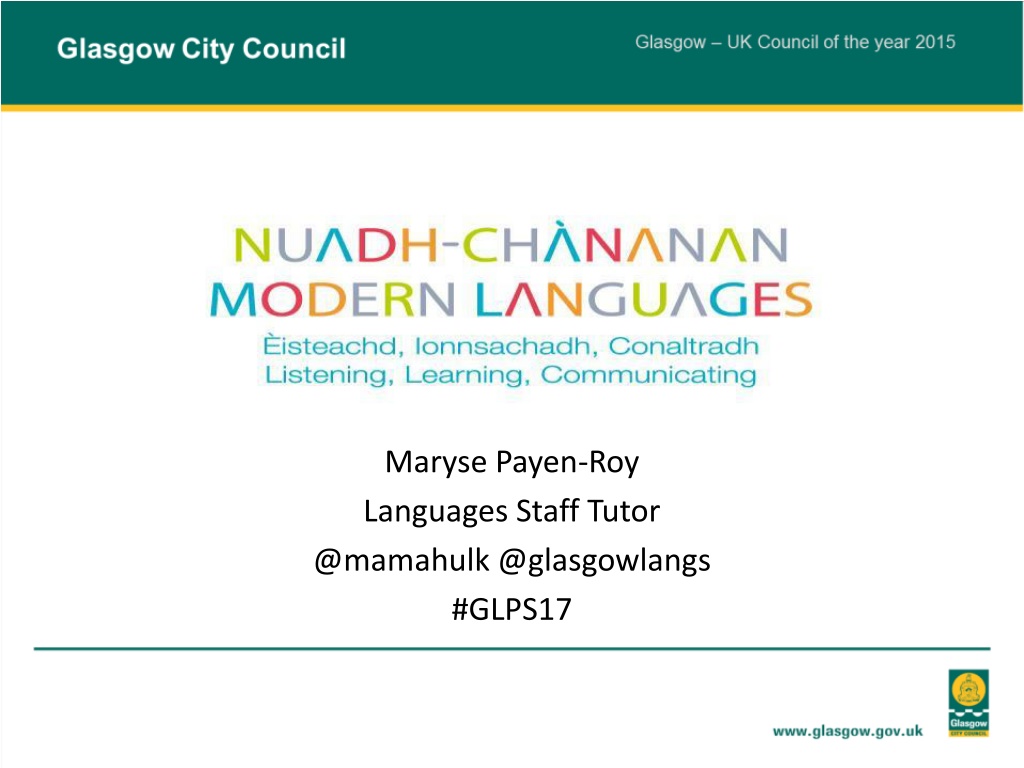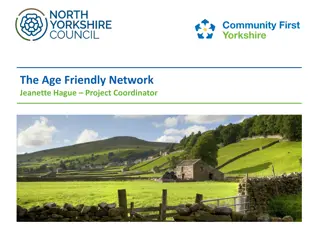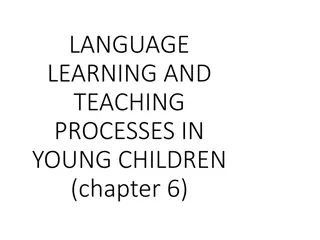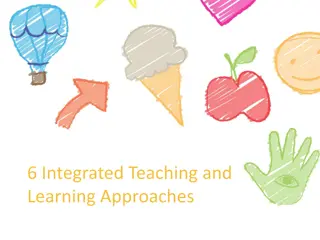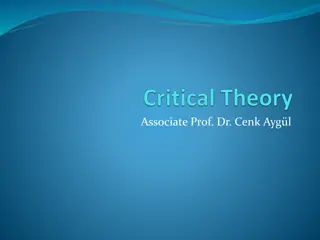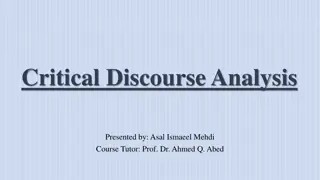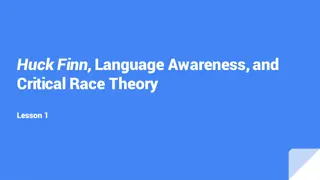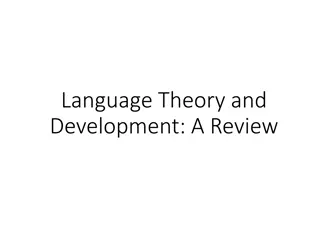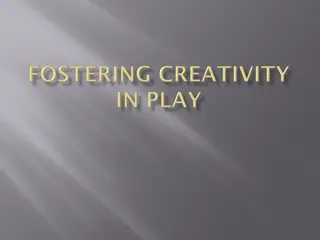The Role of Play in Language Learning and the Critical Age Theory
The critical age theory suggests that young children have greater brain plasticity for language internalization, while adults can learn L2 faster due to developmental stages. Learning a second language early provides advantages in accent acquisition. Affective relationships and play are crucial in language learning, enhancing engagement and development. Playful activities should be incorporated in language teaching for effective learning.
Download Presentation

Please find below an Image/Link to download the presentation.
The content on the website is provided AS IS for your information and personal use only. It may not be sold, licensed, or shared on other websites without obtaining consent from the author. Download presentation by click this link. If you encounter any issues during the download, it is possible that the publisher has removed the file from their server.
E N D
Presentation Transcript
Maryse Payen-Roy Languages Staff Tutor @mamahulk @glasgowlangs #GLPS17
The Critical age theory . There seems indeed to be a period whereby the plasticity of young children s brain would allow them to internalise new systems more effectively; whereas older brains have a more rigid structure that doesn t allow the creation of new infrastructures but merely allowing their analysis through existing grids thus impacting on the depth of absorption of new systems. Or so it is described by Myriam Met in Critical issues in Early second language Learning (1998). M P-R Gaelic conference 2017
However As long as one isn t looking for native like language skills it is also agreed that over the same period of time adults have the capacity to learn L2 faster and that they reach a higher level of competence faster. This is mainly due to developmental stages and access to a more sophisticated way of learning. Rod Ellis (1999) Carol K Sigleman and Elizabeth A Rider, Marianne Nikolov (2009) M P-R Gaelic conference 2017
Nonetheless Many agree that there are some advantages to learning a L2 at an earlier stage even though it is accepted that the outcome might not be native like competences. Young children are uninhibited, more open to new cultures and concepts and will reproduce foreign sounds more readily and achieve better accents. Myriam Met (1998) Rod Ellis (1999) M P-R Gaelic conference 2017
The importance of affective relationship in language learning. In Krashens words, the learner has to be affectively disposed to let in the input. Elaine Weitzman & Janice Greenberg (2002) If the adult is a trusted and well liked figure he/she is much more likely to be accepted in the games children play allowing this grown-up to gently introduce angles which will enrich the experience for the children. Thus classroom teachers seem much better placed to deliver a ML than a visiting specialist. MP-R M P-R Gaelic conference 2017
Methodology Play is a major component of the way young children learn. Mary D Sheridan 1977 "It is a natural way to engage with the reality of the environment around them, whether it be concrete interaction with solid materials, accessing abstract concepts, mastering motor development or practising social skills, etc. Mary D Sheridan (1977) Play feeds development which in turn feeds the quality of play. The introduction of a modern language should include playful activities as a motivating context to practice the language being introduced.MP-R M P-R Gaelic conference 2017
Common observations A silent period is a natural stage when children are learning their first language. It ties in with the (much shorter) silent stage which appears when pupils learn a second language. A lot of oral / aural repetition is needed before you can expect the learners to produce the name for a given item. Also it is worth mentioning that errors exists in both L1 and L2 and are transitional forms of language before a rule acquisition. Indeed many skills development features seem to appear in both L1 and L2 acquisition. M P-R Gaelic conference 2017
Draw on all senses to stimulate learning. Brain research points to the importance of the five senses in relating information. The right hand hemisphere receives sensorial signals and because of the right brain s link to emotions it releases pleasurable signals. This encourages the child to repeat the experience and leads to enhanced learning. Howard Gardner ( ) Janet Moyles (2010) Using activities involving all senses when introducing new language will not only make the experience more relevant and realistic it will also maximise the learning potential of the children. MP-R
Simplified speech and repetitions are key in L2 as in L1 acquisition. Learners need input that is adjusted to their level. Rod Ellis (1999) The child might not understand the FL but can be helped if the teacher remembers to say less, stress, go slow, show . Elaine Weitzman & Janice Greenberg (2002) Teachers should not hesitate to simplify their sentences, exaggerating the important words speaking clearly and slowly and using mimes and gestures to help understanding. This reinforces the importance of imbedding the language in relevant situations which will help to convey meaning. MP-R M P-R Gaelic conference 2017
Learning has to be relevant and purposeful Consistency and repetition are also essential. Young children always find that new knowledge makes more sense if it is linked to something within their own experience. New knowledge for them, needs to have a purpose, this has sometimes been called knowing how rather than knowing that . Pamela May (2011) If an experience occurs daily in the children s routine they are much more likely to learn from it, copy it and absorb it. It is therefore essential that the introduction of a FL is embedded in their daily interaction to achieve maximum impact. Elaine Weitzman & Janice Greenberg (2002) M P-R Gaelic conference 2017
Explicit and Implicit acquisition. The former is the conscious effort to learn rules and structures, study a language to be able to use it; the latter is the subconscious absorbing of a language through passive exposure. Our aim is to achieve a balance whereby the children are explicitly taught some aspects of the language but hopefully will also implicitly absorb most of the language through repeated exposure to relevant phrases in meaningful contexts. Do use ML to comment on / describe daily routine events such as morning greetings, choice of snacks, expressing basic needs which can be used repeatedly. This improves the ML recycling appeal and maximises its impact. MP-R M P-R Gaelic conference 2017
skills introduction: Receptive first Practitioner introduces language orally: 1. Learners just listen (silent period / internalise) 2. Students repeat (Use variety of activity to maximise aural exposure to new language: repeat after P / repeat after echo/ repeat if it is true only / repeat in different voices ) 3. Students listen and show understanding (Respond appropriately to commands / mime action (Jacques a dit) / draw item as directed / select relevant prop or Flash cards / jump to correct Flash card in four corner game /circle or write appropriate item on the board in line game ) M P-R Gaelic conference 2017
Skills progression: productive 1. Learners answer yes or no / true or false / name correct answer Practitioner gives learner a choice (support supplied) 2. Practitioner doesn t give oral support but asks learner to name something in the ML (number / colour / pet / any piece of target language) 3. Learners have to produce the language autonomously. (What s this? / What s missing? (card missing in a sequence / prop from a display / hidden item ) / guess! (teacher s favourite weather or number or pet../ psychic power / next card etc / name items + article in knots and crosses team game, etc..)
Skills progression: the written word A good indicator that learners are ready to see the written word is once they are able to name items fairly independently. It is important to stress out silent letters and main sound s spelling ( u or ou ? an or on ). Once the pupils can match the written word to the associated item you can introduce simple reading activities, (Matching up / sequencing short text or sentence components /) before moving on to short paragraphs and texts. Opportunities for writing might develop from gap filling with the support of a word bank, labelling, writing captions using reference materials, to manipulating and adapting existing text (eg: writing frames), using a dictionary to expand language range, etc M P-R Gaelic conference 2017
Careful planning and flexibility: conundrum? There is both a need for careful planning and identification of the potential learning outcomes linked to the experience arising from an activity and a need for flexibility as the children might actually take the learning experience in a totally different direction to the one anticipated by the adult who planned it. Pamela May(2011) This type of responsive teaching places a greater demand on the creativity and flexibility of the teacher. Careful planning: as you shouldn t lose sight of your learning intentions and place them firmly in a sustainable framework which allows for continuity and progression. Flexibility: as the practitioner has to identify opportunities for embedding the ML in the daily Teaching and Learning experience and sometimes has to make unplanned links with the ML. MP-R
